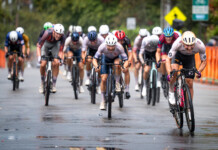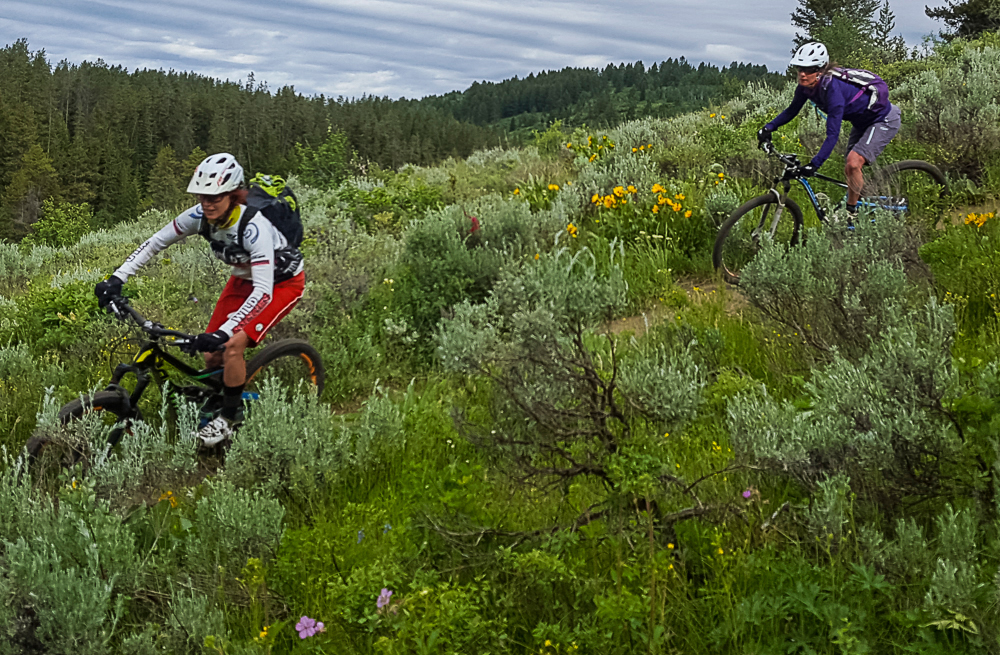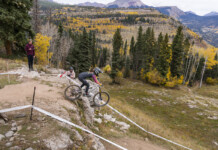The Tour Divide is often referred to as “the most challenging mountain bike race on the planet.” Few would argue it’s a beast. The self-supported race covers 2,745 miles of the Great Divide Mountain Bike Route, which traverses the mountain-rippled spine of the continent from Banff, Alberta, to Antelope Wells, New Mexico. There is a reported 200,000 feet of elevation gain over the distance, through remote and often relentlessly harsh terrain dominated by cows, mosquitoes and bears.
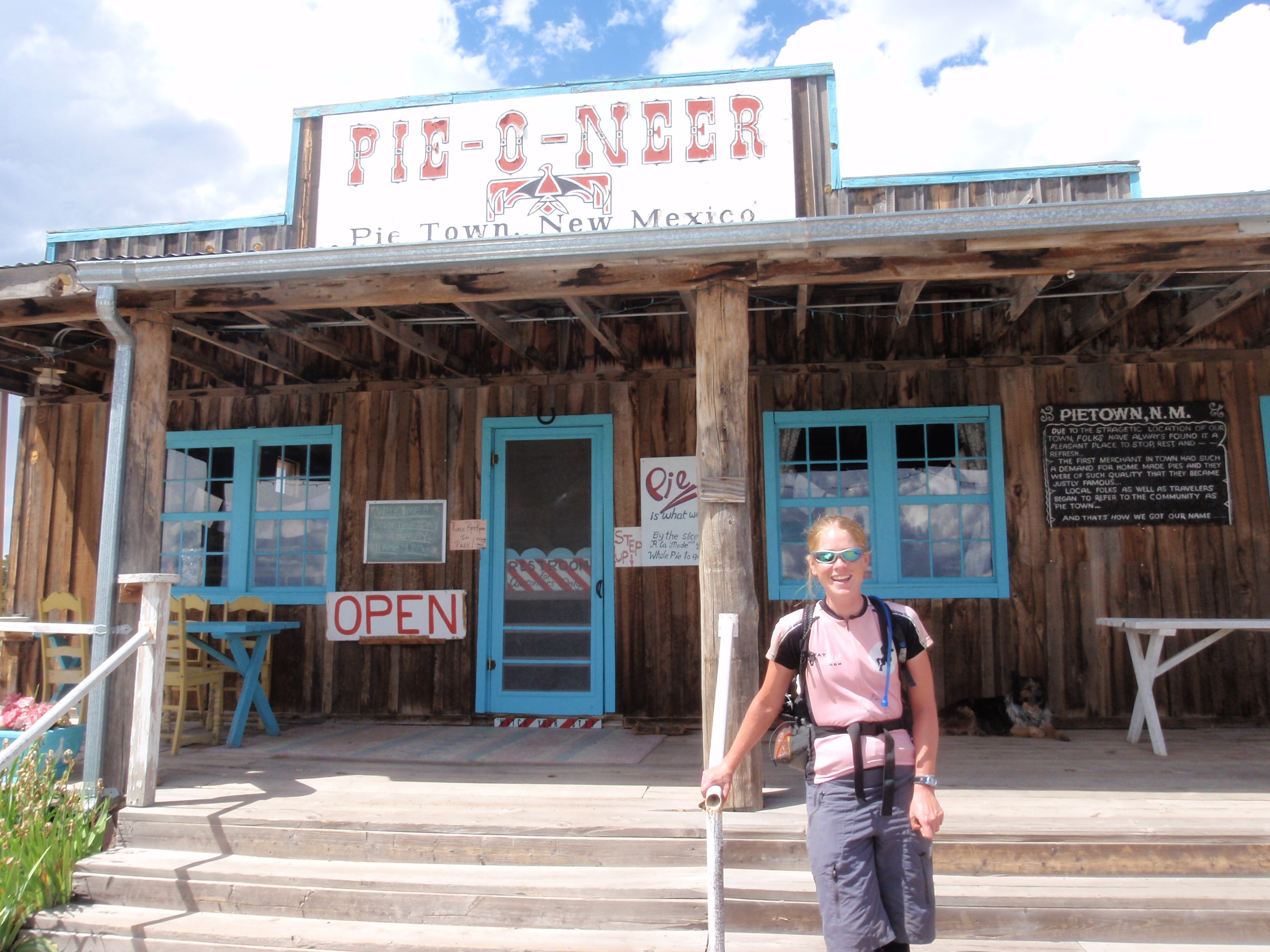
“Tour Divide has no designated rest periods or set distances a racer must travel daily,“ the Web site reports. “The clock runs non-stop. She or he who can ride the fastest while making fewer, shorter stops usually wins.”
And while this is true, just finishing the Tour Divide takes much more than speed and determination – it takes a fair share of grit and tenacity, and appreciation of the stops and starts that are inevitable when spending two or three weeks racing a bicycle.
Jill Homer, a Utah native who currently lives in Anchorage, Alaska, set the women’s record on the race in 2009, arriving in Antelope Wells in 24 days, 7 hours and 24 minutes. Of 42 starters, she was one of 16 to officially finish last year‘s race. The following is her account of a day on the Tour Divide – Independence Day – and why sometimes it’s the stops that make all of the difference.
…..
On July 4, I woke up to brilliant sunlight and crisp air. It tasted like morning in the early fall, with hints of seltzer and wood smoke. I stocked up at the last gas station in town and checked my maps for the phone number to the Pie-O-Neer café in Pie Town. I had already accepted that clinging to the hope it would be open on a national holiday was futile at best, but I had heard entire legends formed around the pie in Pie Town. That one stop was likely my only shot at human interaction in the next 300 miles, so even a futile chance was worth a try.
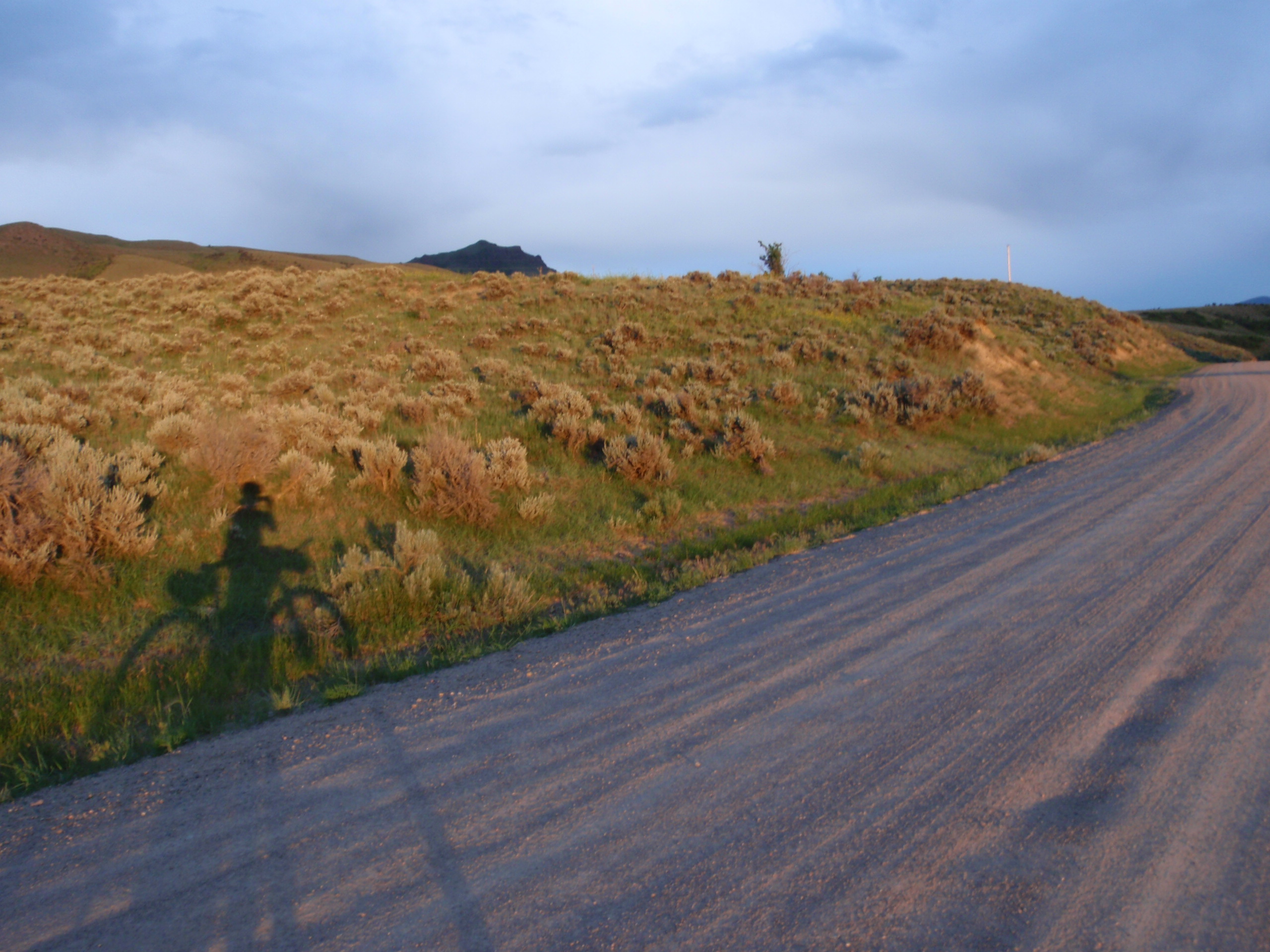
At 8:30 a.m., an answering machine informed me that the café was open Wednesday through Saturday, 11 a.m. to 4 p.m. They said nothing about July 4 specifically, but at least there was a chance they were open that day. Still, even my best-case scenarios made reaching it seem impossible. Pie Town was 80 miles away. Even if there was no mud on the road, an impossible-sounding prospect in itself, my chances of pedaling that far in just over seven hours were unlikely at best. The answering machine beeped, and without planning to, I suddenly launched into a pleading message:
“Hi, my name is Jill. I’m traveling through town on a bicycle with the Tour Divide. Perhaps you’ve seen other bikers come through. Anyway, I’m calling from Grants. It’s 8:30 a.m. Saturday. I’m going to try to make it there by 4, but it’s 80 miles and with the mud, well, it’s not very likely I’ll be there before you close. I was wondering if you could leave out some kind of lunch, maybe a sandwich or something, and a piece of pie, and a gallon of water, along with a check, and I’ll leave cash. I don’t even care what it is. I pretty much just need calories at this point, calories and water. Please. I’m good for it. I have a lot of cash. My name is Jill Homer.”
I set out with determination to make the 4 p.m. deadline, come what may. As the derelict highway buildings of Grants faded behind me, a bubble of emotion expanded inside my gut. I felt a strong mixture of gratitude and love, as well as loneliness, fear and despair. I couldn’t discern where all of it was coming from. I was rested, well fed and riding on pavement within sight of a town full of people. Despite these comforts, tears started to trickle down my cheeks, which erupted into streams, which erupted into open sobbing, complete with flowing snot and gulps of air.
Whenever endurance cyclists embark on long races, people often ask us afterward about the specific point when we realized we could finish what we had set out to do. I always dismissed this question as unanswerable and misleading. To some, I would say that I knew I would eventually finish the Tour Divide when I was all the way back in Montana. To others, I admitted that I wasn’t even sure when I made the final right turn 65 miles from the border. But if I am truly honest with myself, those minutes I spent sobbing on my way out of Grants stand apart as a defining moment of clarity.
As my tears began to slow and my gasps became softer, I pleaded an open prayer to entities I also felt were indefinable – to God, to my inner strength, to the powers that be. “Please be with me. Please stay with me. Please help me get through this.” Something about leaving Grants told me that, barring breakdown or disaster, I was going to finish the Tour Divide. Since I had no control over breakdown or disaster, I pleaded for help from the one thing that might.
The powers that be nodded benevolently and swept me along the smooth corridor of Highway 117. The rugged but sheer cliffs of El Malpais National Monument cast the pavement in cool shadow. After 38 miles, the route joined the washboard ruts of a wide county road. The jittery corduroy soon faded into smooth but soft clay. The area had indeed been pummeled by thunderstorms the night before; blood-colored puddles glistened in the road‘s many dips and potholes. As I rode, my wheels kicked up large clumps of red mud. Still, beneath the late morning sunlight, the mud had hardened just enough to roll into balls and fling away rather than stick to my bike.
“Think light, be light,” I chanted, as though sheer force of will could reduce my weight and keep my wheels floating over the jelly-like layers of mud. Atop a paper-thin veneer of clay, I pedaled apprehensively but quickly, coming close to sinking into the soft mud that undulated beneath my tires, but never quite breaking through the dry layer. I smiled at the knowledge that if I had passed through the same area just a few hours earlier, I would have been mired in wet sludge. Every once in a while, the universe rewards late risers.
Just after 2 p.m., after covering nearly 80 miles in five and a half hours, I strode triumphantly into the open doors of the Pie-O-Neer café. The single-room restaurant was set up modestly with modern tables and old Western art. A guitarist and bassist strummed acoustic country ballads as couples chatted softly over heaping plates of pie. A woman wearing a ruffled apron rushed out from behind the counter and threw her arms around me in an enthusiastic hug. “You made it!” she exclaimed. “I can’t believe you made it!”
“I made it,” I said, smiling widely.
The guitarist had just finished a cover of Johnny Cash’s “Long Black Veil.” “So you’re Jill?” he asked. I nodded. “We did not think you’d make it here until late tonight,” he continued. “It rained all through the night last night, just poured. I knew that road was gone. I sometimes take my horses out there and I know how bad it can get. Even they can‘t get through the mud sometimes. We thought you’d be stuck in it.”
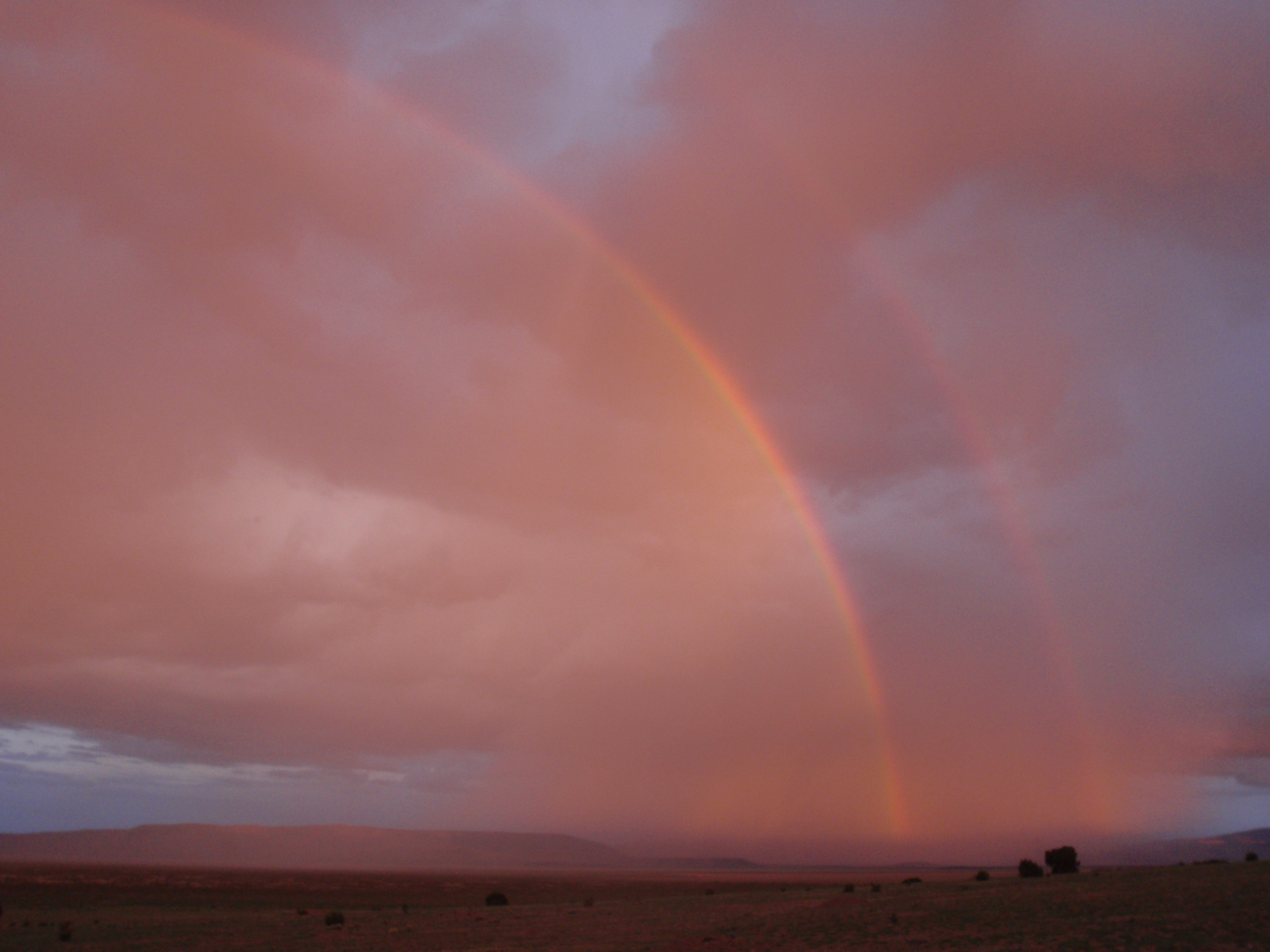
“I thought so, too,” I said. “But it had hardened up in the sun. I got really lucky.”
“Well, anyway, congratulations on getting here from Grants in just a few hours. That’s some incredible riding.”
The woman in the apron nodded. “You should have seen Matt Lee when he came through. It was late but I let him in the door. It had been raining. He was covered in mud. He had this crazy look in his eyes and he just fell in the door mumbling, ‘I need food.’ I said, ‘I know you need food but you’re not coming in here until you clean off that mud.’ I practically had to push him back out the door. I thought, ‘This can’t be healthy.’”
I laughed. I was about to launch into my “Here in mid-pack, we have more fun” speech when she grabbed my shoulders and rushed me to a nearby table. “But you must be starving, riding all the way from Grants,” she said. “What do you want to eat?”
Before I even looked at the menu on the wall, I asked, “Do you have salad?”
“I don’t have salad, but I have some spinach and tomatoes and other veggies in the fridge. Tell you what, I’ll make you one.”
“That would be awesome,” I said.
“And our special today is spinach quesadilla with fresh salsa. We also have a tomato vegetable soup.”
“Those sound amazing, too,” I interrupted. “I’ll have them both. And salad.”
“Do you want something to drink?”
“Um …” I wavered. I had already ordered a lot.
“Common, the other Tour Divide guys were just knocking back pops faster than I could replenish them. What do you want?”
“Do you have Pepsi?” I asked.
“Of course,” she said.
“And you can’t leave here without trying a slice of pie,” she said.
“Of course I can’t.” I took a lingering look at the back wall, lined from end to end with towering desserts. “Um, I’ll try the coconut cream,” I finally said.
“Good choice,” she said. “That one won an award last month from a big-time food magazine.”
As promised, the woman served up cans of Pepsi faster than I could knock them back, and brought me plate after plate of food, hot and fresh and brimming with all the real nutrition I had scarcely known in three weeks of a diet heavy on junk food from gas stations and greasy spoon diners. The woman asked me how my lunch was. “You have no idea how replenishing it is to eat healthy for a change,” I said. “If all Americans could feel this way after eating a spinach salad, McDonalds would go out of business. Which would be awesome, because then people like me could actually find healthy food to eat on the Great Divide.”
The woman laughed. She asked me about the trail prior to Grants and I told her about the shocking remoteness of New Mexico. A man eating pie at the table turned and launched into a stern warning about the dangers of New Mexico‘s backcountry. “There are cougars out there that hunt people,” he said ominously. “I hope you have protection.”
I pointed to the can of bear spray I had been carrying since Canada and had never even come close to discharging, unless I counted the time I pointed it at the vicious dogs of Vallecitos. “I’m from Alaska,” I said. “So I’m well-versed in the defense against predators thing.” I wanted to tell him that I was far more afraid of mud and lightning, of fatigue and bad judgment, of loneliness and fear itself, but it seemed pointless to argue about the most pressing dangers of the Divide.
In the late afternoon, the woman in the apron and guys in the band walked outside to see me off. “It’s just about closing time and we’re all headed to the lake,” she said. “But you have a great ride, and don’t hesitate to come back when you’re through these parts again. Happy Independence Day!”
“You too,” I said, shaking all of their hands. “Thanks for making the best lunch in the entire span of the Rocky Mountains.”
I left Pie Town at 4 p.m. into a brand new day. I felt like I was just waking up from a restful sleep, even though I had 80 miles behind me. “Someday,” I thought, “I’m going to be a veteran of this race and people will ask me the secret to success. I’m going to answer, ‘human kindness.’”
The roller coaster terrain made two nondescript crossings of the Continental Divide. I pedaled past ranches and cut into a canyon, surrounded again by large, triangle-shaped mountains. The remote road intersected with an abandoned town site, an old Spanish mission. I got off my bike and explored the eerie remnants of a slab and mortar church, peering into the cracks of boarded windows and gazing up at a hollow bell tower.
Just beyond the town site, I entered Gila National Forest. My maps informed me: “Camping OK next 14 miles.” I pedaled beneath gnarled and grand juniper trees, rising back into the ponderosa forest, and cresting the Continental Divide once again at a spectacular overlook of the San Agustin plains. I could see thunderstorms building over the distant mountains beyond the valley. It was still early in the evening. “If I don’t stop near here,” I thought, “I’ll have to pedal all the way through that valley before I‘m back in a spot where I can camp.” But I was feeling too incredible to stop. I launched into a gleeful descent toward the darkening sky.
The route crossed onto a country road sparsely lined with private ranches. An occasional ranch house broke the monotony of the sagebrush plains, but for the most part I was alone in vastly open space. The wind blew briskly at my side, whipping around and changing directions intermittently as booms of thunder clattered across the desert.
The thunderstorm I had seen hanging over the horizon began to close in. The bulk of the storm seemed to be moving the same direction I was, but I was approaching it faster than it was streaming away. I glanced over my shoulder and noticed another storm approaching from behind. Sheets of pouring rain hung like curtains beneath black clouds, and frequent flashes of lightning broke through the darkness.
A primal sense of fear gripped my core. My heart pounded. I was pedaling in a tiny window of calm, chasing one violent storm even as another chased me. If I pedaled too fast, I would catch the first storm. If I pedaled too slow, I would be caught by the second storm. I shivered at the prospect of both scenarios, and vowed to do everything in my cycling power to hover in the eye between two hurricanes.
It was shortly after I made this decision that I heard a sickeningly loud zipping sound. My bike’s rear tire became more and more bouncy and sluggish until I had no choice but to stop and deal with the flat. I had been using “Slime” inner tubes, which were filled with green sealant intended to coat and block any holes that happened to be punctured in the tube. They had worked beautifully for the duration of the Divide, and I had yet to spring a leak that wasn‘t quickly blocked, requiring only a few refresher hits from my air pump. This was the first time a tire had gone completely flat. It was my rear tire, which required the loosening of the brake caliper before I could remove the wheel. A rear flat change usually took me at least 10 minutes when I was fresh, and as many as 20 when I was hurried and frustrated. I knew I did not have 20 minutes to spare before I would be caught directly beneath a barrage of lightning and rain. I did not even have 5 minutes.
“Be brave,” I chanted through gulping breaths as I hopped off the bike. “Be strong.”
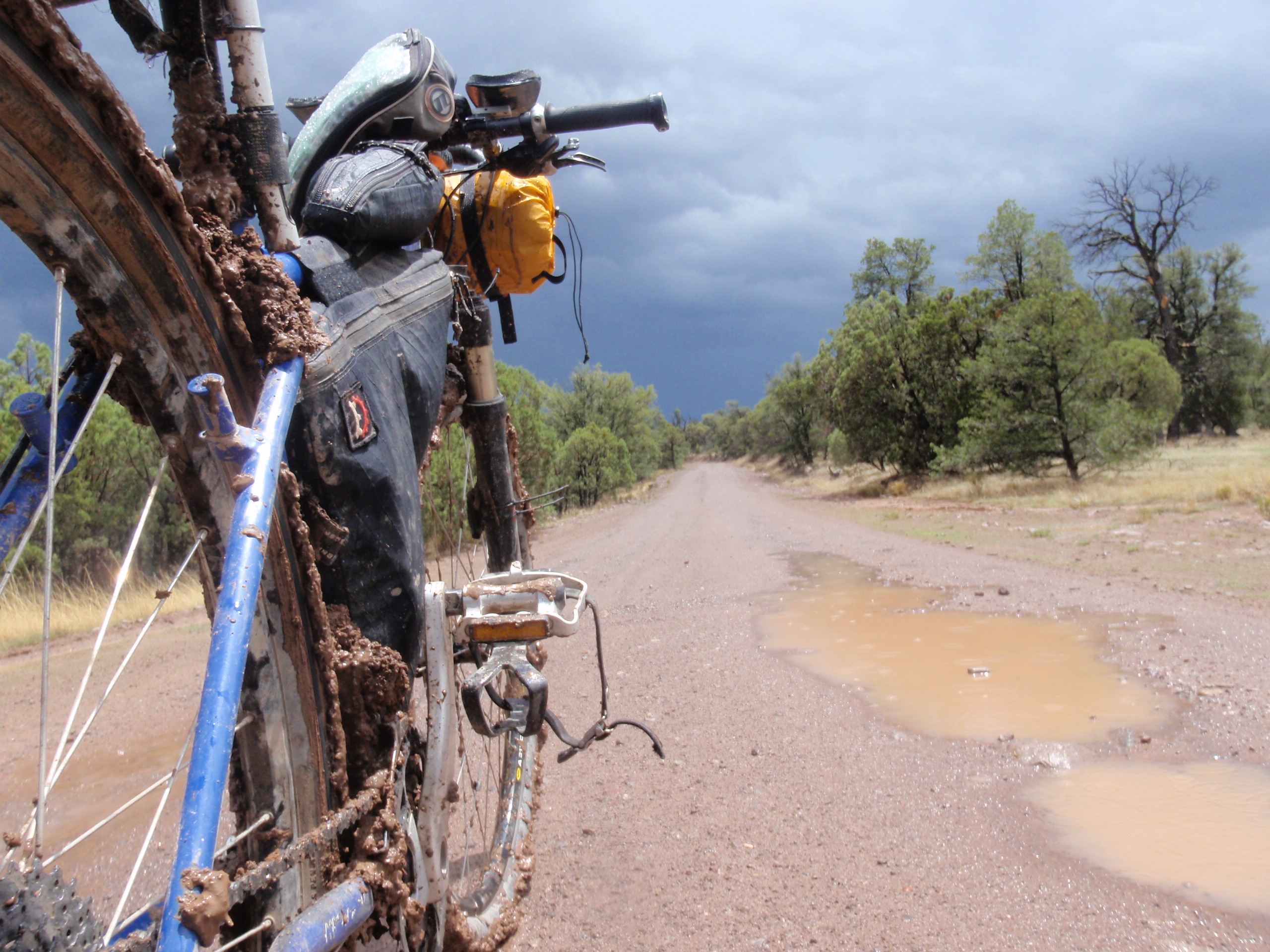
A thick streak of green slime coated the down tube of the frame. I was sure all the sealant had leaked out and there was nothing left to fill the hole. But it was possible that I had just sprung a larger leak that took a while to clog. It seemed worth a try to pump up the tire rather than change the tube right away. The extra time it would take if it didn’t work wasn’t going to save me from the storm either way, but if that’s all it took, there was still a chance I could outrun the air strike.
I breathed in and out with every stroke of the air pump, continuing to chant, “Be brave. Be strong.” As I pumped, the sun slipped beneath the nearest mountains. The sky, already under siege, burst open in an explosion of crimson and gold light. The sudden blast of color reflected off the dark clouds in a contrast so bright that the entire sky shimmered. Where sunset’s saturated light met the sheets of rain, broad rainbows swept over the desert. I counted five rainbows at one point, arched in wide spans that framed the phosphorescent clouds. And beneath the rainbow stage, steaks of lightning performed a violent ballet.
The scene did nothing to reduce the panic gurgling in my gut. Still, from where I sat in my shrinking window of peace, trying my best to breathe to the rhythm of my air pump, I knew that I was witnessing a moment of powerful beauty – beauty that was more powerful even than fear. I briefly closed my eyes and tried to absorb the awe, the sheer terror and wonder that nature was unleashing before me. I felt like I was clinging to the precipice between heaven and hell, and if I happened to fall, no matter which direction I went, I would be wholly absorbed forever.
I injected a few last shots of air into the tire. It was still fairly soft, about 20 psi, but I didn’t hear any more of that terrible zipping sound, and I thought there was a better than even chance that it would hold the air. I hopped back on the saddle and pedaled wildly; trying to regain the distance I had lost on the second storm. I pedaled right into the heart of the largest, brightest rainbow and its undulating electric daggers. I was still fully aware that I was the tallest object for miles, on an open plain without even a sagebrush bush large enough to huddle behind. I briefly thought about veering off on a ranch road and sprinting one or two miles to the nearest structure in search of shelter, but I fought the urge. “Be brave,” I chanted. “Be strong.”
The spectacular light of the sunset lingered much longer than I even thought possible, as though it, like me, was afraid to fade into the darker regions of eternity. It didn’t take long to catch the aftermath of the first storm. The road was coated in wet mud and two-inch-deep puddles, but rain had moved on. The second storm slowed its advance and started to move mercifully to the east. My own route veered west and began climbing back into the mountains.
When I reached the mouth of a canyon, I stopped one last time to look out over the plains of San Agustin. Sunset’s crimson and orange flames were almost snuffed out, except for thin, blood-colored streaks that bordered the horizon. Lightning continued to pierce the purple twilight, followed closely by booms of thunder. As I watched the storm march east, I noticed tiny blue flashes of light erupting from the northern horizon. They confused me at first – they were too low to be lightning, but too large and sporadic to be light from a ranch house. I squinted and realized they were fireworks, set off over a ranch at least 20 miles in the distance.
“Oh yeah,” I said out loud. “It’s the Fourth of July.” I watched the tiny streams of blue light sparkle and then fade, over and over, as flashes and booms of lightning and thunder nearly overwhelmed the tiny celebration.
“Why don’t they just look up and realize that the most spectacular show is going on in nature?” I wondered. Their efforts seemed so small and pathetic in a world that was so vast and so powerful. Humans were nothing out here, nothing at all.
Darkness encompassed me with the rising canyon. For a while I could still hear the thunder, and then only the wind and stillness. Rainwater coated the road and the air was moist and cool. The sky had broken into a patchwork quilt of starlight and clouds. A nearly full moon rose overhead, casting a ghostly glow on an assemblage of sandstone hoodoos. I rolled out my sleeping bag on the bare dirt beneath a cluster of ponderosa pines. I breathed in my rich satisfaction. With a little sprinkling of effort and a heavy dollop of grace, I had knocked out 140 miles in the 14 hours behind me, with only 250 more to go.
“Thank you,” I said in continuation of my morning prayer. “That was a good day.”
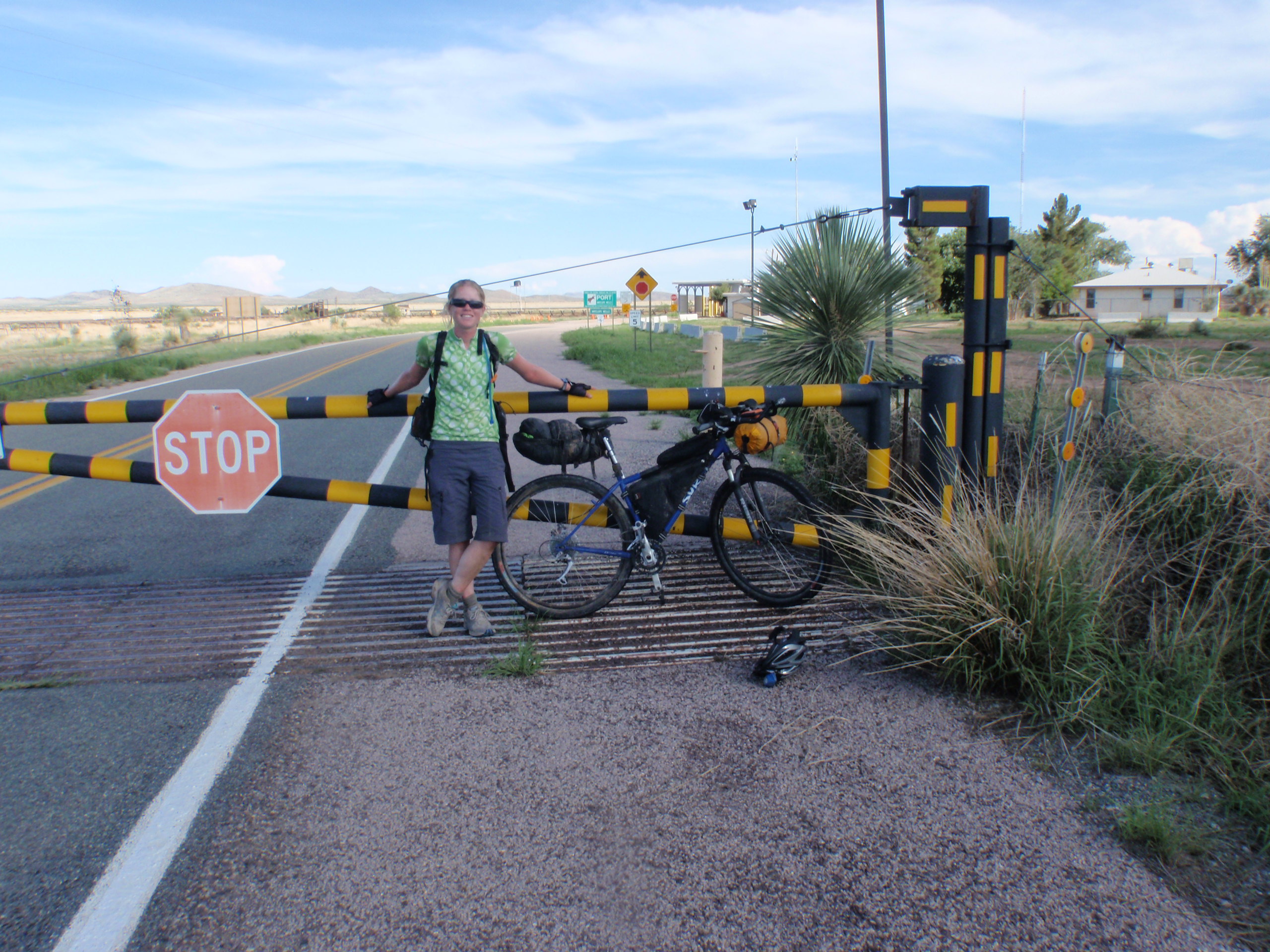
after finishing the Tour Divide in 24 days, 7 hours and 24 minutes. Photo courtesy Jill Homer
Jill is a journalist and cyclist living in Anchorage, Alaska. You can follow her adventures at http://www.jilloutside.com/

